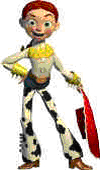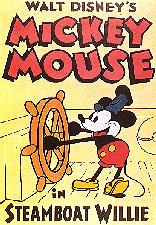Pixar began as a computer company which concentrated on developing computer hard/software; they were partners with Disney in this field, for whom they invented a computer-assisted animation post-production software system. Unfortunately, their business did not flourish and they began to produce computer-generated commercials for other companies, which proved to be successful. In 1991, Pixar made a deal with Walt Disney Studios to produce computer-animated feature films, the first of which was Toy Story. They agreed on Disney financing the movie completely and retaining the rights to each movie character as well as the sequels. In this way, Pixar could profit from Disney's elaborate distribution system and all the connections they needed. But financially seen, Disney obviously made more profit than Pixar could ever dream of since they received 87 percent of all the profits made.
In their early days, Walt Disney and his brother Roy were subcontractors for the cartoon segment of RKO Radio Pictures. In 1954, after eighteen years of cooperation, Disney broke up with RKO and the two brothers founded their own distribution firm, Buena Vista Distribution. Pixar now has the full responsibility of the 3D-feature films for Disney, which evokes reminiscences of the first years of the Disney Company itself. After a rather unstable time, which was caused by Pixar wanting to change the former contract with Disney, the economic future is now secured.
Post-production is the part of filmmaking which comes after the actual shooting of a script; in this process, the film material is edited, special and audio effects are added and the colors are graded. Specialized post-production companies exist, such as George Lucas' Industrial Light and Magic. The post-production also includes recording a movie's soundtrack.
Distribution in film business means taking care of all the marketing (advertisements in print, audio and visual media) as well as the sale of videos, laserdiscs, and other media versions of movies. It is the connection between a film maker / film production company and an exhibitioner, notably the movie theatres. Well-known distribution corporations are Columbia Pictures, Fox Film, Tobis Forenfilms and Metro-Goldwyn-Meyer.
Shareholders can also be called stockholders and are individuals or companies who hold shares (dt.: Aktien) of a joint stock company (dt.: Aktiengesellschaft). In this way, they own the initial capital (dt.: Grundkapital) in the form of shares. They therefore have special privileges such as electing the board of directors of a company and taking part in the Annual General Meeting, where important decisions about a company's future are made.
In 1928 Disney produced his first Mickey
Mouse cartoon, "Steamboat Willy", which was also the first animated cartoon
with sound. The mouse was the central character for the development of
one of the strongest brands
in the worldwide media business and, in addition, the start of the substantial
merchandising business of the Disney group. The first leisure park, "Disneyland",
opened in California in 1955. In the 50s Disney established itself in
the television branch with its weekly "Disneyland" show on ABC Network
and the "Mickey Mouse Club". The founder Walt Disney started the company
off with a strong brand philosophy, which was based on the purity of the
products. The brand became an American myth, guaranteed without erotic
liberality or presentation of violence. Until his death in 1966 Walt Disney
influenced the enterprise with his imagination. Afterwards the ever present
"spirit of Walt" inhibited the further development of Disney. There was
little modernization and among actors the studios were considered to be
fusty and old-fashioned. Promising projects were turned down, producing
flops. Soon the company found itself in financial trouble. In the 80s the Disney group passed through a
deep crisis. The share price
slumped heavily and a hostile
takeover with subsequent sellout was lurking. But in 1984 an investor was
attracted, and with a new management around Michael Eisner (from Paramount)
and Frank Wells (from Warner Bros.), known as the "Disney team", the modernization
of the Company started and the Walt Disney Company expanded to its present-day
size.
The crisis in the advertising and tourism industry,
reinforced by the terrorist attacks of September 11, has put the world´s third
largest media group under stronger pressure than rival media groups. About 90%
of Disney´s profit comes from media networks, including TV stations and
theme parks - two areas which have been particularly affected by the economic
slowdown and the effects of the attacks. The disclination of many customers to travel
and the tendency of international tourists to avoid the USA is mainly perceivable
in the theme park "Disneyworld" in Florida. The attendance slumped 25% in the
quarter after September 11. TV business has also been hit by the problems.
On the one hand the advertising
revenue has slumped massively as a result of the commercial-free reporting
after the attacks; on the other hand the stations are suffering from a decline
of the television ratings
of 21%, which has led to lower advertising
fees. 
Steve Jobs tried several times to negotiate the conditions of this contract with Michael Eisner, who was Disney's CEO at the time, but Eisner would not give in to any new suggestions; for example, Jobs wanted to take 100 percent of all profits and pay Disney only a distribution fee. In January 2004, Jobs therefore announced that Pixar would not renew their former contract. The search for a new partner turned out to be difficult, however, since every potential candidate (such as Warner Bros., Sony Pictures and 20th Century Fox) feared the commercial success they had would have to achieve in competition with any sequel Disney would produce on their own. Finally, Jobs came to terms with Robert Iger, Disney's new CEO since last October, and Disney bought Pixar for 7.4 billion dollars on January 24th, 2006, thus cementing the marriage.

For Pixar's CEO, Steve Jobs, the deal between him and Disney's new CEO Robert Iger turned out to be more than good. He is Disney's largest shareholder (he owns 6 percent of the Disney shares) and remains chairman as well as CEO of Pixar. Observers are even talking of him as the probable next Disney chairman. As he still is CEO of the Apple Computer Company, whom he and his partners founded in 1976, he profits in a double way since it could become possible that Apple offers Disney's full-length features on their iTunes Music Store, as they did with successful TV formats such as "Desperate Housewives" and "Lost". Apple already worked together with Disney in the past, since the filmmakers counted on innovative hardware produced by Apple to give life to their stories This relationship will surely be intensified. Shareholders and analysts reacted positively to the change, which was reflected in Pixar shares rising 3 percent on January 25,, 2006.
Vision and Advertising
Walt Disney Studios: Survival of a Dream Factory
History

It was the start of a new age: Drastic economy measures were the first step
in restructuring the rusty group. The "Disney team" decided to pay no exorbitant
honoraria in film production any longer. A crucial step was the spectacular
$19 billion takeover of the Capital Cities/ABC group in 1997, which guaranteed
the Disney group the control over numerous TV stations. During the crisis in
1984 the company was worth less than $2 billion; in 2000 its value amounted
to approximately $60 billion. When Eisner and Wells joined the Company, they
made lucrative arrangements like percentage profit
and share options. Another attribute of the Disney culture is the organization
and the discipline of the company. The stainlessness of the Disney brands corresponds
with the meticulous organization and tidiness in the theme parks. There is a
clear ruling regarding appearance, clothing and behavior of the personnel.
A step further to realize Disney´s dream was the construction of the "ideal
town" called Celebration City in Orlando in 1996, a kind of lived cartoon. The
city with its 5,000 inhabitants is propagated as a milestone in modern town
and social planning. It favours the nostalgic ideal of pre-industrial innocence,
under strictly social and aesthetic dictates. Current Development